Exploring the Mediating Role of Engagement in Human Resource Management
VerifiedAdded on 2019/12/18
|15
|5014
|209
Literature Review
AI Summary
The mediating role of engagement in human resource management is an important aspect to consider when understanding the relationship between employee engagement and organizational performance. According to studies, engagement can serve as a mediator between leadership and organizational outcomes, indicating that leaders who are more supportive of their employees' needs can increase employee engagement, which in turn leads to improved job satisfaction, reduced turnover, and better overall performance.
Contribute Materials
Your contribution can guide someone’s learning journey. Share your
documents today.
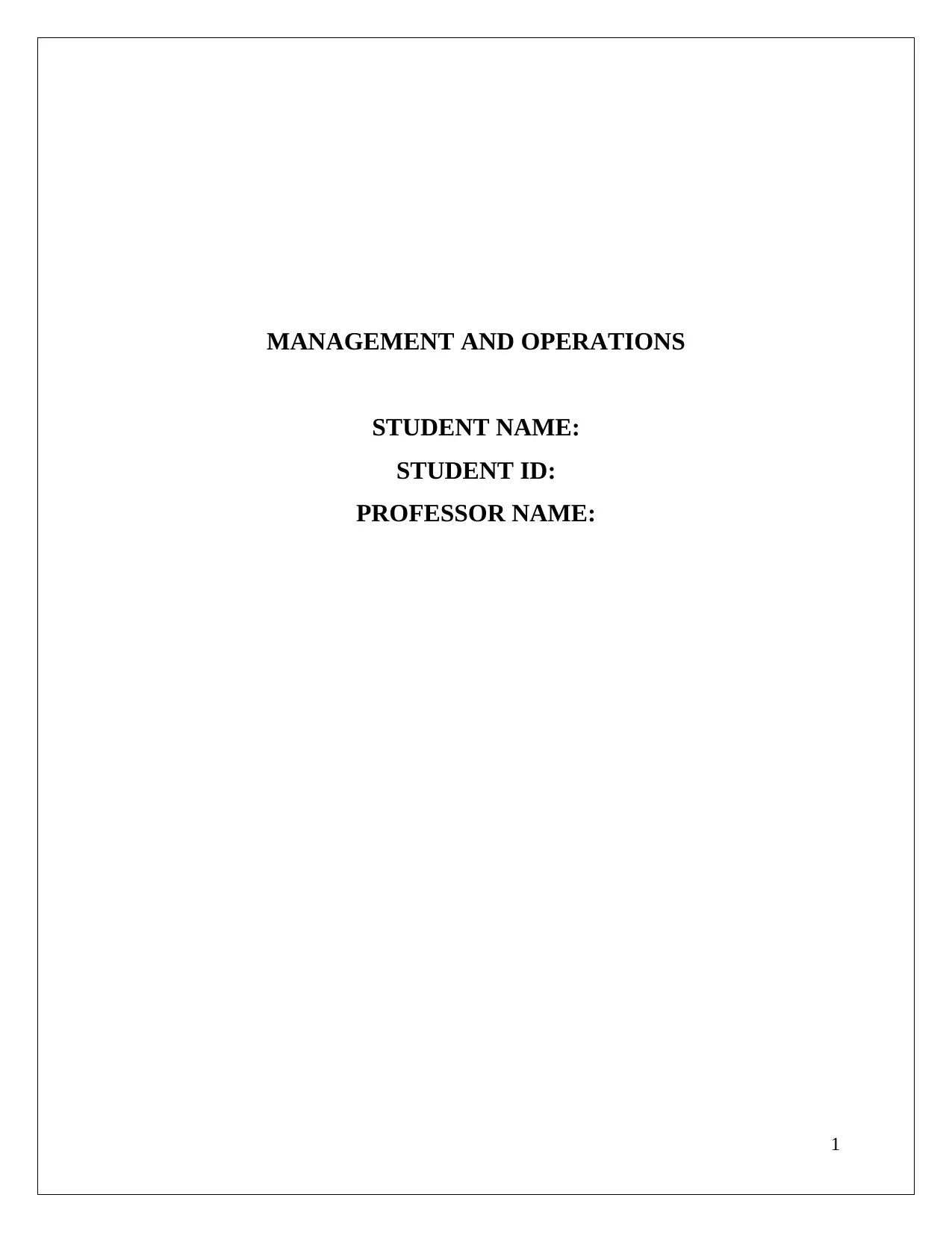
MANAGEMENT AND OPERATIONS
STUDENT NAME:
STUDENT ID:
PROFESSOR NAME:
1
STUDENT NAME:
STUDENT ID:
PROFESSOR NAME:
1
Secure Best Marks with AI Grader
Need help grading? Try our AI Grader for instant feedback on your assignments.
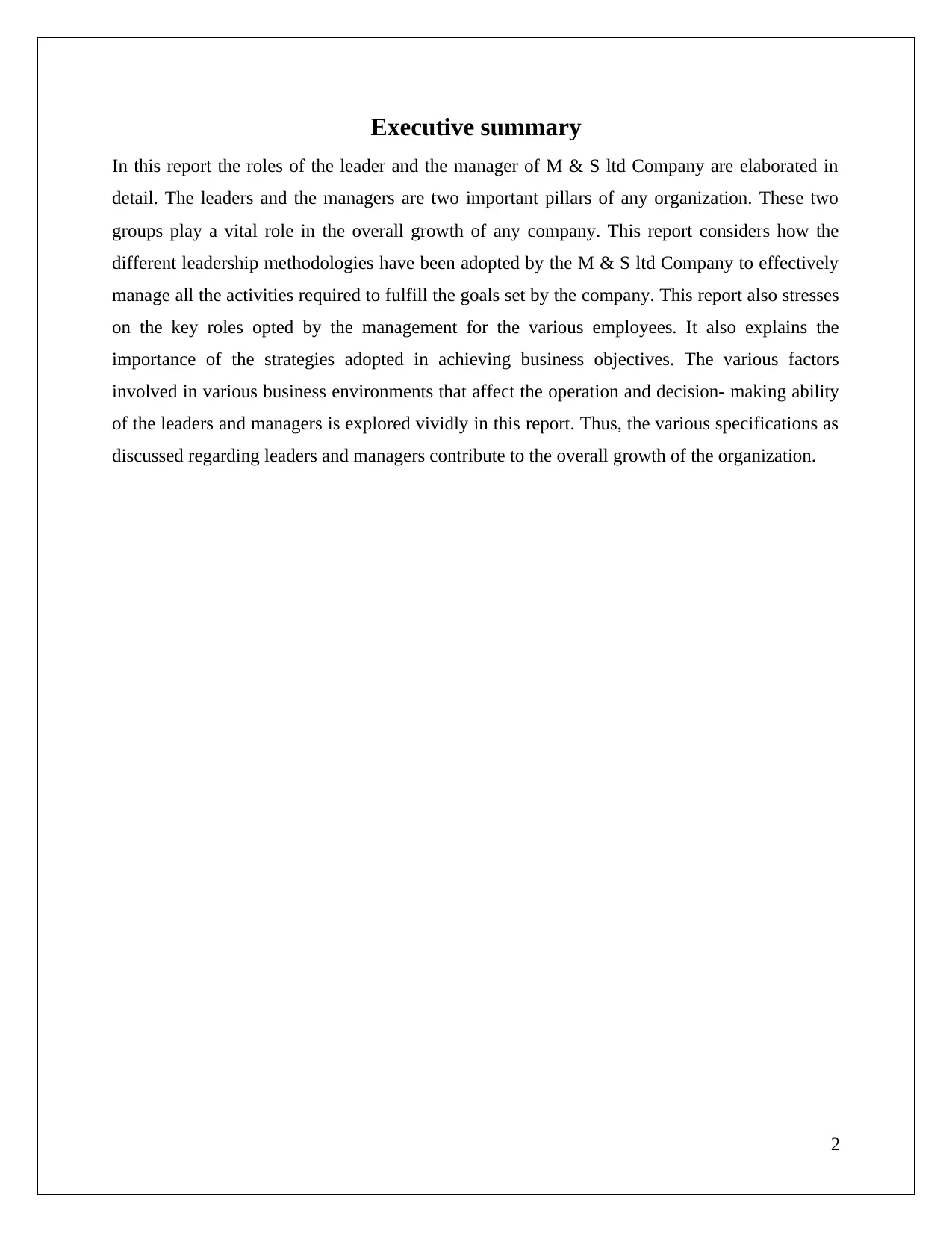
Executive summary
In this report the roles of the leader and the manager of M & S ltd Company are elaborated in
detail. The leaders and the managers are two important pillars of any organization. These two
groups play a vital role in the overall growth of any company. This report considers how the
different leadership methodologies have been adopted by the M & S ltd Company to effectively
manage all the activities required to fulfill the goals set by the company. This report also stresses
on the key roles opted by the management for the various employees. It also explains the
importance of the strategies adopted in achieving business objectives. The various factors
involved in various business environments that affect the operation and decision- making ability
of the leaders and managers is explored vividly in this report. Thus, the various specifications as
discussed regarding leaders and managers contribute to the overall growth of the organization.
2
In this report the roles of the leader and the manager of M & S ltd Company are elaborated in
detail. The leaders and the managers are two important pillars of any organization. These two
groups play a vital role in the overall growth of any company. This report considers how the
different leadership methodologies have been adopted by the M & S ltd Company to effectively
manage all the activities required to fulfill the goals set by the company. This report also stresses
on the key roles opted by the management for the various employees. It also explains the
importance of the strategies adopted in achieving business objectives. The various factors
involved in various business environments that affect the operation and decision- making ability
of the leaders and managers is explored vividly in this report. Thus, the various specifications as
discussed regarding leaders and managers contribute to the overall growth of the organization.
2
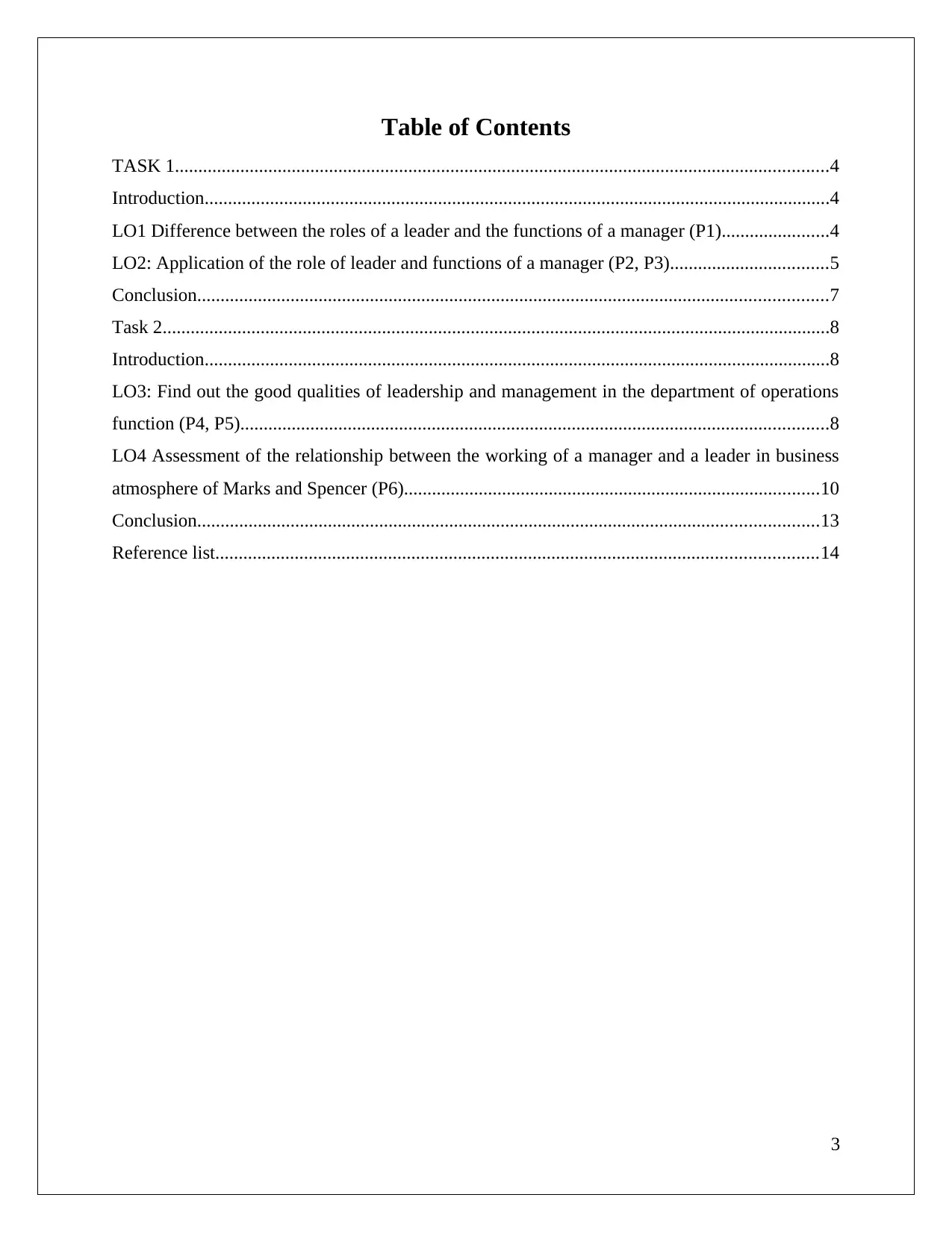
Table of Contents
TASK 1............................................................................................................................................4
Introduction......................................................................................................................................4
LO1 Difference between the roles of a leader and the functions of a manager (P1).......................4
LO2: Application of the role of leader and functions of a manager (P2, P3)..................................5
Conclusion.......................................................................................................................................7
Task 2...............................................................................................................................................8
Introduction......................................................................................................................................8
LO3: Find out the good qualities of leadership and management in the department of operations
function (P4, P5)..............................................................................................................................8
LO4 Assessment of the relationship between the working of a manager and a leader in business
atmosphere of Marks and Spencer (P6).........................................................................................10
Conclusion.....................................................................................................................................13
Reference list.................................................................................................................................14
3
TASK 1............................................................................................................................................4
Introduction......................................................................................................................................4
LO1 Difference between the roles of a leader and the functions of a manager (P1).......................4
LO2: Application of the role of leader and functions of a manager (P2, P3)..................................5
Conclusion.......................................................................................................................................7
Task 2...............................................................................................................................................8
Introduction......................................................................................................................................8
LO3: Find out the good qualities of leadership and management in the department of operations
function (P4, P5)..............................................................................................................................8
LO4 Assessment of the relationship between the working of a manager and a leader in business
atmosphere of Marks and Spencer (P6).........................................................................................10
Conclusion.....................................................................................................................................13
Reference list.................................................................................................................................14
3
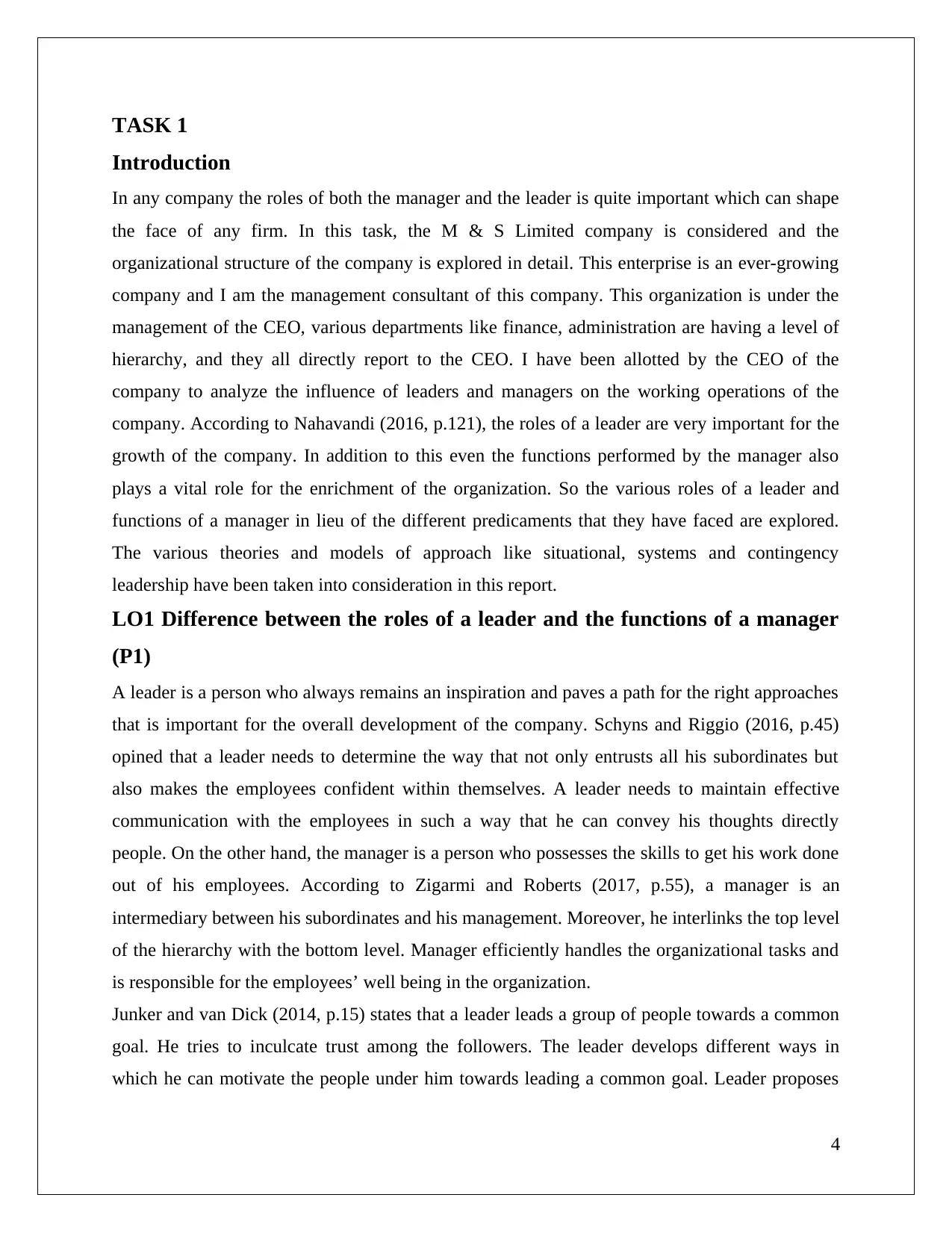
TASK 1
Introduction
In any company the roles of both the manager and the leader is quite important which can shape
the face of any firm. In this task, the M & S Limited company is considered and the
organizational structure of the company is explored in detail. This enterprise is an ever-growing
company and I am the management consultant of this company. This organization is under the
management of the CEO, various departments like finance, administration are having a level of
hierarchy, and they all directly report to the CEO. I have been allotted by the CEO of the
company to analyze the influence of leaders and managers on the working operations of the
company. According to Nahavandi (2016, p.121), the roles of a leader are very important for the
growth of the company. In addition to this even the functions performed by the manager also
plays a vital role for the enrichment of the organization. So the various roles of a leader and
functions of a manager in lieu of the different predicaments that they have faced are explored.
The various theories and models of approach like situational, systems and contingency
leadership have been taken into consideration in this report.
LO1 Difference between the roles of a leader and the functions of a manager
(P1)
A leader is a person who always remains an inspiration and paves a path for the right approaches
that is important for the overall development of the company. Schyns and Riggio (2016, p.45)
opined that a leader needs to determine the way that not only entrusts all his subordinates but
also makes the employees confident within themselves. A leader needs to maintain effective
communication with the employees in such a way that he can convey his thoughts directly
people. On the other hand, the manager is a person who possesses the skills to get his work done
out of his employees. According to Zigarmi and Roberts (2017, p.55), a manager is an
intermediary between his subordinates and his management. Moreover, he interlinks the top level
of the hierarchy with the bottom level. Manager efficiently handles the organizational tasks and
is responsible for the employees’ well being in the organization.
Junker and van Dick (2014, p.15) states that a leader leads a group of people towards a common
goal. He tries to inculcate trust among the followers. The leader develops different ways in
which he can motivate the people under him towards leading a common goal. Leader proposes
4
Introduction
In any company the roles of both the manager and the leader is quite important which can shape
the face of any firm. In this task, the M & S Limited company is considered and the
organizational structure of the company is explored in detail. This enterprise is an ever-growing
company and I am the management consultant of this company. This organization is under the
management of the CEO, various departments like finance, administration are having a level of
hierarchy, and they all directly report to the CEO. I have been allotted by the CEO of the
company to analyze the influence of leaders and managers on the working operations of the
company. According to Nahavandi (2016, p.121), the roles of a leader are very important for the
growth of the company. In addition to this even the functions performed by the manager also
plays a vital role for the enrichment of the organization. So the various roles of a leader and
functions of a manager in lieu of the different predicaments that they have faced are explored.
The various theories and models of approach like situational, systems and contingency
leadership have been taken into consideration in this report.
LO1 Difference between the roles of a leader and the functions of a manager
(P1)
A leader is a person who always remains an inspiration and paves a path for the right approaches
that is important for the overall development of the company. Schyns and Riggio (2016, p.45)
opined that a leader needs to determine the way that not only entrusts all his subordinates but
also makes the employees confident within themselves. A leader needs to maintain effective
communication with the employees in such a way that he can convey his thoughts directly
people. On the other hand, the manager is a person who possesses the skills to get his work done
out of his employees. According to Zigarmi and Roberts (2017, p.55), a manager is an
intermediary between his subordinates and his management. Moreover, he interlinks the top level
of the hierarchy with the bottom level. Manager efficiently handles the organizational tasks and
is responsible for the employees’ well being in the organization.
Junker and van Dick (2014, p.15) states that a leader leads a group of people towards a common
goal. He tries to inculcate trust among the followers. The leader develops different ways in
which he can motivate the people under him towards leading a common goal. Leader proposes
4
Secure Best Marks with AI Grader
Need help grading? Try our AI Grader for instant feedback on your assignments.
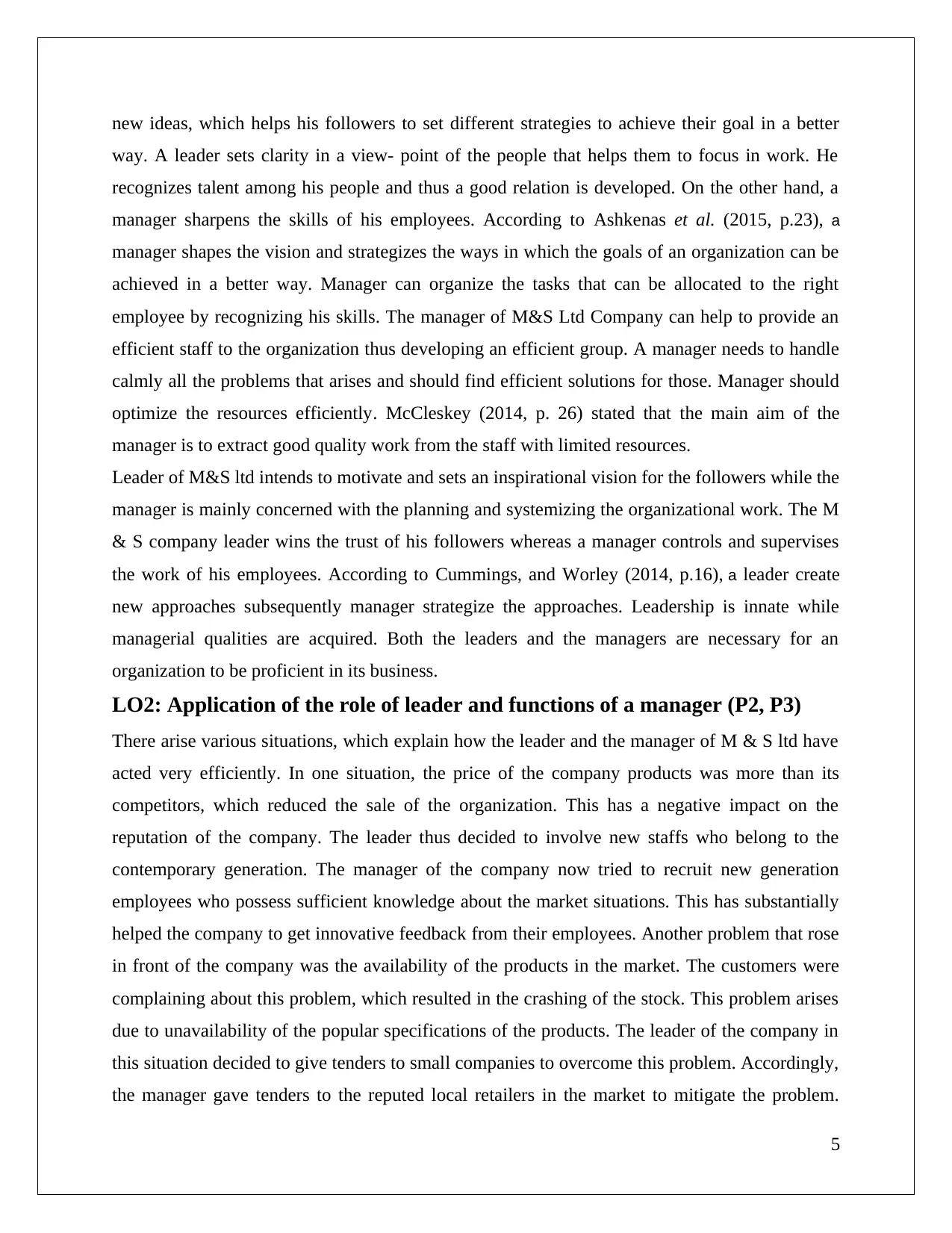
new ideas, which helps his followers to set different strategies to achieve their goal in a better
way. A leader sets clarity in a view- point of the people that helps them to focus in work. He
recognizes talent among his people and thus a good relation is developed. On the other hand, a
manager sharpens the skills of his employees. According to Ashkenas et al. (2015, p.23), a
manager shapes the vision and strategizes the ways in which the goals of an organization can be
achieved in a better way. Manager can organize the tasks that can be allocated to the right
employee by recognizing his skills. The manager of M&S Ltd Company can help to provide an
efficient staff to the organization thus developing an efficient group. A manager needs to handle
calmly all the problems that arises and should find efficient solutions for those. Manager should
optimize the resources efficiently. McCleskey (2014, p. 26) stated that the main aim of the
manager is to extract good quality work from the staff with limited resources.
Leader of M&S ltd intends to motivate and sets an inspirational vision for the followers while the
manager is mainly concerned with the planning and systemizing the organizational work. The M
& S company leader wins the trust of his followers whereas a manager controls and supervises
the work of his employees. According to Cummings, and Worley (2014, p.16), a leader create
new approaches subsequently manager strategize the approaches. Leadership is innate while
managerial qualities are acquired. Both the leaders and the managers are necessary for an
organization to be proficient in its business.
LO2: Application of the role of leader and functions of a manager (P2, P3)
There arise various situations, which explain how the leader and the manager of M & S ltd have
acted very efficiently. In one situation, the price of the company products was more than its
competitors, which reduced the sale of the organization. This has a negative impact on the
reputation of the company. The leader thus decided to involve new staffs who belong to the
contemporary generation. The manager of the company now tried to recruit new generation
employees who possess sufficient knowledge about the market situations. This has substantially
helped the company to get innovative feedback from their employees. Another problem that rose
in front of the company was the availability of the products in the market. The customers were
complaining about this problem, which resulted in the crashing of the stock. This problem arises
due to unavailability of the popular specifications of the products. The leader of the company in
this situation decided to give tenders to small companies to overcome this problem. Accordingly,
the manager gave tenders to the reputed local retailers in the market to mitigate the problem.
5
way. A leader sets clarity in a view- point of the people that helps them to focus in work. He
recognizes talent among his people and thus a good relation is developed. On the other hand, a
manager sharpens the skills of his employees. According to Ashkenas et al. (2015, p.23), a
manager shapes the vision and strategizes the ways in which the goals of an organization can be
achieved in a better way. Manager can organize the tasks that can be allocated to the right
employee by recognizing his skills. The manager of M&S Ltd Company can help to provide an
efficient staff to the organization thus developing an efficient group. A manager needs to handle
calmly all the problems that arises and should find efficient solutions for those. Manager should
optimize the resources efficiently. McCleskey (2014, p. 26) stated that the main aim of the
manager is to extract good quality work from the staff with limited resources.
Leader of M&S ltd intends to motivate and sets an inspirational vision for the followers while the
manager is mainly concerned with the planning and systemizing the organizational work. The M
& S company leader wins the trust of his followers whereas a manager controls and supervises
the work of his employees. According to Cummings, and Worley (2014, p.16), a leader create
new approaches subsequently manager strategize the approaches. Leadership is innate while
managerial qualities are acquired. Both the leaders and the managers are necessary for an
organization to be proficient in its business.
LO2: Application of the role of leader and functions of a manager (P2, P3)
There arise various situations, which explain how the leader and the manager of M & S ltd have
acted very efficiently. In one situation, the price of the company products was more than its
competitors, which reduced the sale of the organization. This has a negative impact on the
reputation of the company. The leader thus decided to involve new staffs who belong to the
contemporary generation. The manager of the company now tried to recruit new generation
employees who possess sufficient knowledge about the market situations. This has substantially
helped the company to get innovative feedback from their employees. Another problem that rose
in front of the company was the availability of the products in the market. The customers were
complaining about this problem, which resulted in the crashing of the stock. This problem arises
due to unavailability of the popular specifications of the products. The leader of the company in
this situation decided to give tenders to small companies to overcome this problem. Accordingly,
the manager gave tenders to the reputed local retailers in the market to mitigate the problem.
5
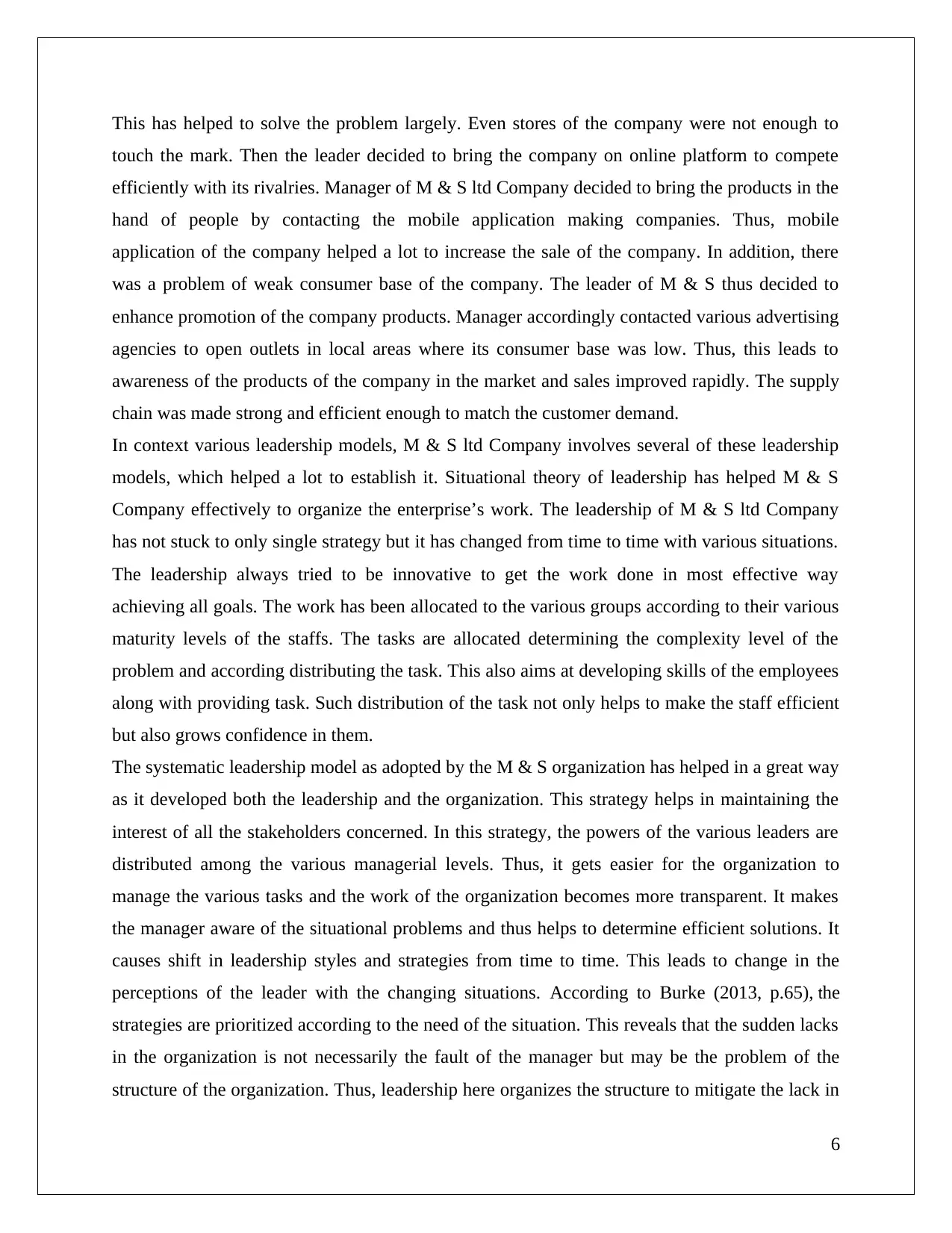
This has helped to solve the problem largely. Even stores of the company were not enough to
touch the mark. Then the leader decided to bring the company on online platform to compete
efficiently with its rivalries. Manager of M & S ltd Company decided to bring the products in the
hand of people by contacting the mobile application making companies. Thus, mobile
application of the company helped a lot to increase the sale of the company. In addition, there
was a problem of weak consumer base of the company. The leader of M & S thus decided to
enhance promotion of the company products. Manager accordingly contacted various advertising
agencies to open outlets in local areas where its consumer base was low. Thus, this leads to
awareness of the products of the company in the market and sales improved rapidly. The supply
chain was made strong and efficient enough to match the customer demand.
In context various leadership models, M & S ltd Company involves several of these leadership
models, which helped a lot to establish it. Situational theory of leadership has helped M & S
Company effectively to organize the enterprise’s work. The leadership of M & S ltd Company
has not stuck to only single strategy but it has changed from time to time with various situations.
The leadership always tried to be innovative to get the work done in most effective way
achieving all goals. The work has been allocated to the various groups according to their various
maturity levels of the staffs. The tasks are allocated determining the complexity level of the
problem and according distributing the task. This also aims at developing skills of the employees
along with providing task. Such distribution of the task not only helps to make the staff efficient
but also grows confidence in them.
The systematic leadership model as adopted by the M & S organization has helped in a great way
as it developed both the leadership and the organization. This strategy helps in maintaining the
interest of all the stakeholders concerned. In this strategy, the powers of the various leaders are
distributed among the various managerial levels. Thus, it gets easier for the organization to
manage the various tasks and the work of the organization becomes more transparent. It makes
the manager aware of the situational problems and thus helps to determine efficient solutions. It
causes shift in leadership styles and strategies from time to time. This leads to change in the
perceptions of the leader with the changing situations. According to Burke (2013, p.65), the
strategies are prioritized according to the need of the situation. This reveals that the sudden lacks
in the organization is not necessarily the fault of the manager but may be the problem of the
structure of the organization. Thus, leadership here organizes the structure to mitigate the lack in
6
touch the mark. Then the leader decided to bring the company on online platform to compete
efficiently with its rivalries. Manager of M & S ltd Company decided to bring the products in the
hand of people by contacting the mobile application making companies. Thus, mobile
application of the company helped a lot to increase the sale of the company. In addition, there
was a problem of weak consumer base of the company. The leader of M & S thus decided to
enhance promotion of the company products. Manager accordingly contacted various advertising
agencies to open outlets in local areas where its consumer base was low. Thus, this leads to
awareness of the products of the company in the market and sales improved rapidly. The supply
chain was made strong and efficient enough to match the customer demand.
In context various leadership models, M & S ltd Company involves several of these leadership
models, which helped a lot to establish it. Situational theory of leadership has helped M & S
Company effectively to organize the enterprise’s work. The leadership of M & S ltd Company
has not stuck to only single strategy but it has changed from time to time with various situations.
The leadership always tried to be innovative to get the work done in most effective way
achieving all goals. The work has been allocated to the various groups according to their various
maturity levels of the staffs. The tasks are allocated determining the complexity level of the
problem and according distributing the task. This also aims at developing skills of the employees
along with providing task. Such distribution of the task not only helps to make the staff efficient
but also grows confidence in them.
The systematic leadership model as adopted by the M & S organization has helped in a great way
as it developed both the leadership and the organization. This strategy helps in maintaining the
interest of all the stakeholders concerned. In this strategy, the powers of the various leaders are
distributed among the various managerial levels. Thus, it gets easier for the organization to
manage the various tasks and the work of the organization becomes more transparent. It makes
the manager aware of the situational problems and thus helps to determine efficient solutions. It
causes shift in leadership styles and strategies from time to time. This leads to change in the
perceptions of the leader with the changing situations. According to Burke (2013, p.65), the
strategies are prioritized according to the need of the situation. This reveals that the sudden lacks
in the organization is not necessarily the fault of the manager but may be the problem of the
structure of the organization. Thus, leadership here organizes the structure to mitigate the lack in
6
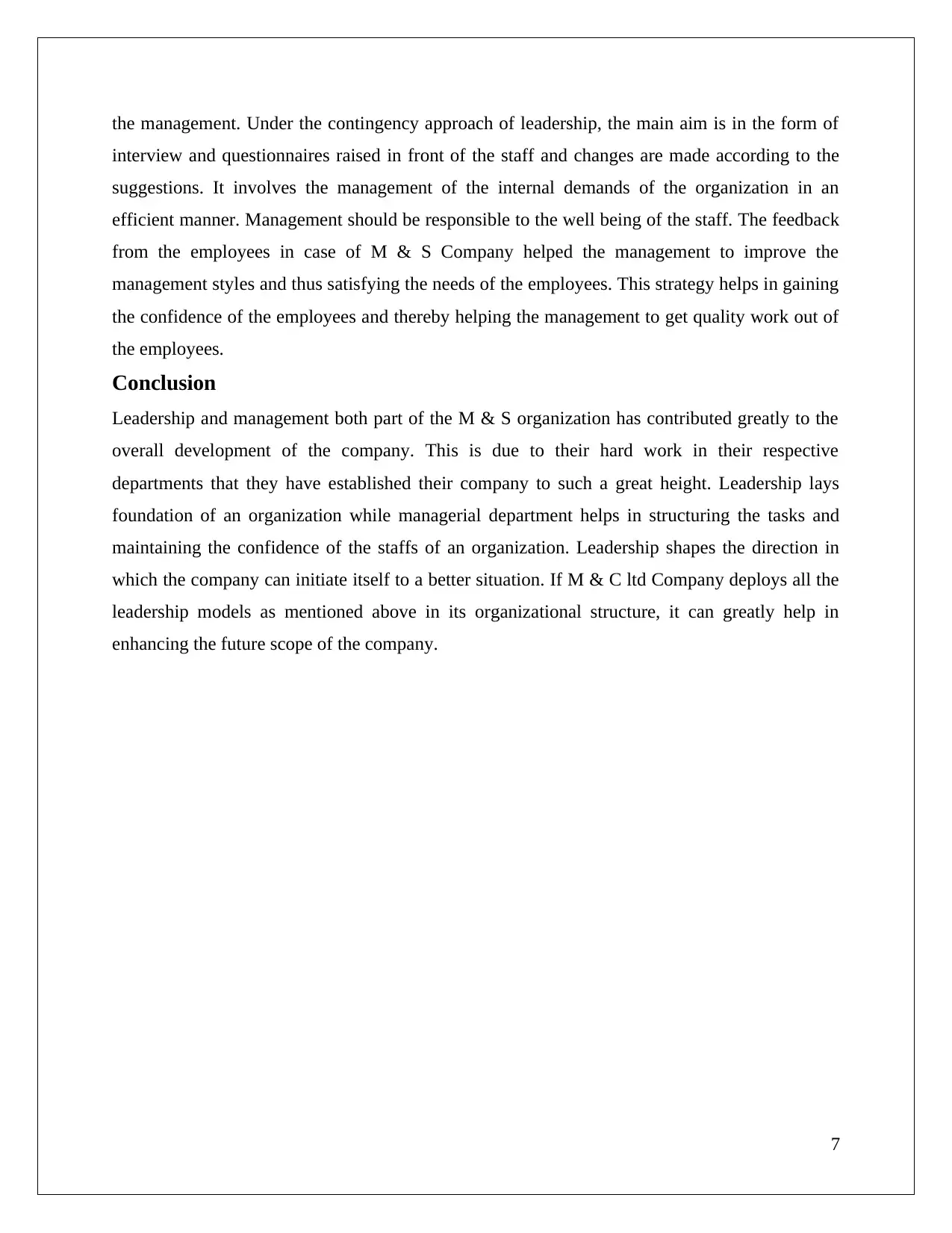
the management. Under the contingency approach of leadership, the main aim is in the form of
interview and questionnaires raised in front of the staff and changes are made according to the
suggestions. It involves the management of the internal demands of the organization in an
efficient manner. Management should be responsible to the well being of the staff. The feedback
from the employees in case of M & S Company helped the management to improve the
management styles and thus satisfying the needs of the employees. This strategy helps in gaining
the confidence of the employees and thereby helping the management to get quality work out of
the employees.
Conclusion
Leadership and management both part of the M & S organization has contributed greatly to the
overall development of the company. This is due to their hard work in their respective
departments that they have established their company to such a great height. Leadership lays
foundation of an organization while managerial department helps in structuring the tasks and
maintaining the confidence of the staffs of an organization. Leadership shapes the direction in
which the company can initiate itself to a better situation. If M & C ltd Company deploys all the
leadership models as mentioned above in its organizational structure, it can greatly help in
enhancing the future scope of the company.
7
interview and questionnaires raised in front of the staff and changes are made according to the
suggestions. It involves the management of the internal demands of the organization in an
efficient manner. Management should be responsible to the well being of the staff. The feedback
from the employees in case of M & S Company helped the management to improve the
management styles and thus satisfying the needs of the employees. This strategy helps in gaining
the confidence of the employees and thereby helping the management to get quality work out of
the employees.
Conclusion
Leadership and management both part of the M & S organization has contributed greatly to the
overall development of the company. This is due to their hard work in their respective
departments that they have established their company to such a great height. Leadership lays
foundation of an organization while managerial department helps in structuring the tasks and
maintaining the confidence of the staffs of an organization. Leadership shapes the direction in
which the company can initiate itself to a better situation. If M & C ltd Company deploys all the
leadership models as mentioned above in its organizational structure, it can greatly help in
enhancing the future scope of the company.
7
Paraphrase This Document
Need a fresh take? Get an instant paraphrase of this document with our AI Paraphraser
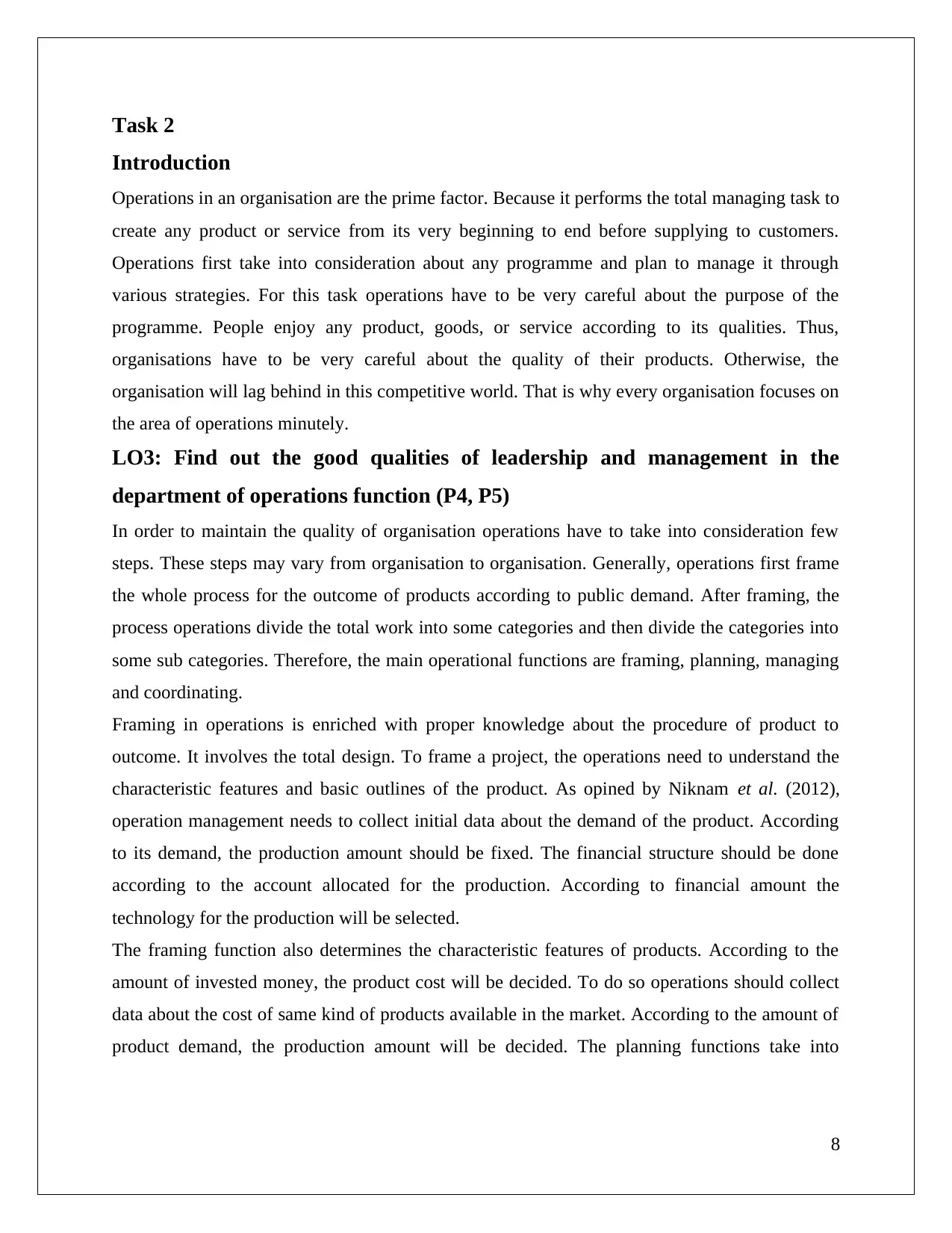
Task 2
Introduction
Operations in an organisation are the prime factor. Because it performs the total managing task to
create any product or service from its very beginning to end before supplying to customers.
Operations first take into consideration about any programme and plan to manage it through
various strategies. For this task operations have to be very careful about the purpose of the
programme. People enjoy any product, goods, or service according to its qualities. Thus,
organisations have to be very careful about the quality of their products. Otherwise, the
organisation will lag behind in this competitive world. That is why every organisation focuses on
the area of operations minutely.
LO3: Find out the good qualities of leadership and management in the
department of operations function (P4, P5)
In order to maintain the quality of organisation operations have to take into consideration few
steps. These steps may vary from organisation to organisation. Generally, operations first frame
the whole process for the outcome of products according to public demand. After framing, the
process operations divide the total work into some categories and then divide the categories into
some sub categories. Therefore, the main operational functions are framing, planning, managing
and coordinating.
Framing in operations is enriched with proper knowledge about the procedure of product to
outcome. It involves the total design. To frame a project, the operations need to understand the
characteristic features and basic outlines of the product. As opined by Niknam et al. (2012),
operation management needs to collect initial data about the demand of the product. According
to its demand, the production amount should be fixed. The financial structure should be done
according to the account allocated for the production. According to financial amount the
technology for the production will be selected.
The framing function also determines the characteristic features of products. According to the
amount of invested money, the product cost will be decided. To do so operations should collect
data about the cost of same kind of products available in the market. According to the amount of
product demand, the production amount will be decided. The planning functions take into
8
Introduction
Operations in an organisation are the prime factor. Because it performs the total managing task to
create any product or service from its very beginning to end before supplying to customers.
Operations first take into consideration about any programme and plan to manage it through
various strategies. For this task operations have to be very careful about the purpose of the
programme. People enjoy any product, goods, or service according to its qualities. Thus,
organisations have to be very careful about the quality of their products. Otherwise, the
organisation will lag behind in this competitive world. That is why every organisation focuses on
the area of operations minutely.
LO3: Find out the good qualities of leadership and management in the
department of operations function (P4, P5)
In order to maintain the quality of organisation operations have to take into consideration few
steps. These steps may vary from organisation to organisation. Generally, operations first frame
the whole process for the outcome of products according to public demand. After framing, the
process operations divide the total work into some categories and then divide the categories into
some sub categories. Therefore, the main operational functions are framing, planning, managing
and coordinating.
Framing in operations is enriched with proper knowledge about the procedure of product to
outcome. It involves the total design. To frame a project, the operations need to understand the
characteristic features and basic outlines of the product. As opined by Niknam et al. (2012),
operation management needs to collect initial data about the demand of the product. According
to its demand, the production amount should be fixed. The financial structure should be done
according to the account allocated for the production. According to financial amount the
technology for the production will be selected.
The framing function also determines the characteristic features of products. According to the
amount of invested money, the product cost will be decided. To do so operations should collect
data about the cost of same kind of products available in the market. According to the amount of
product demand, the production amount will be decided. The planning functions take into
8
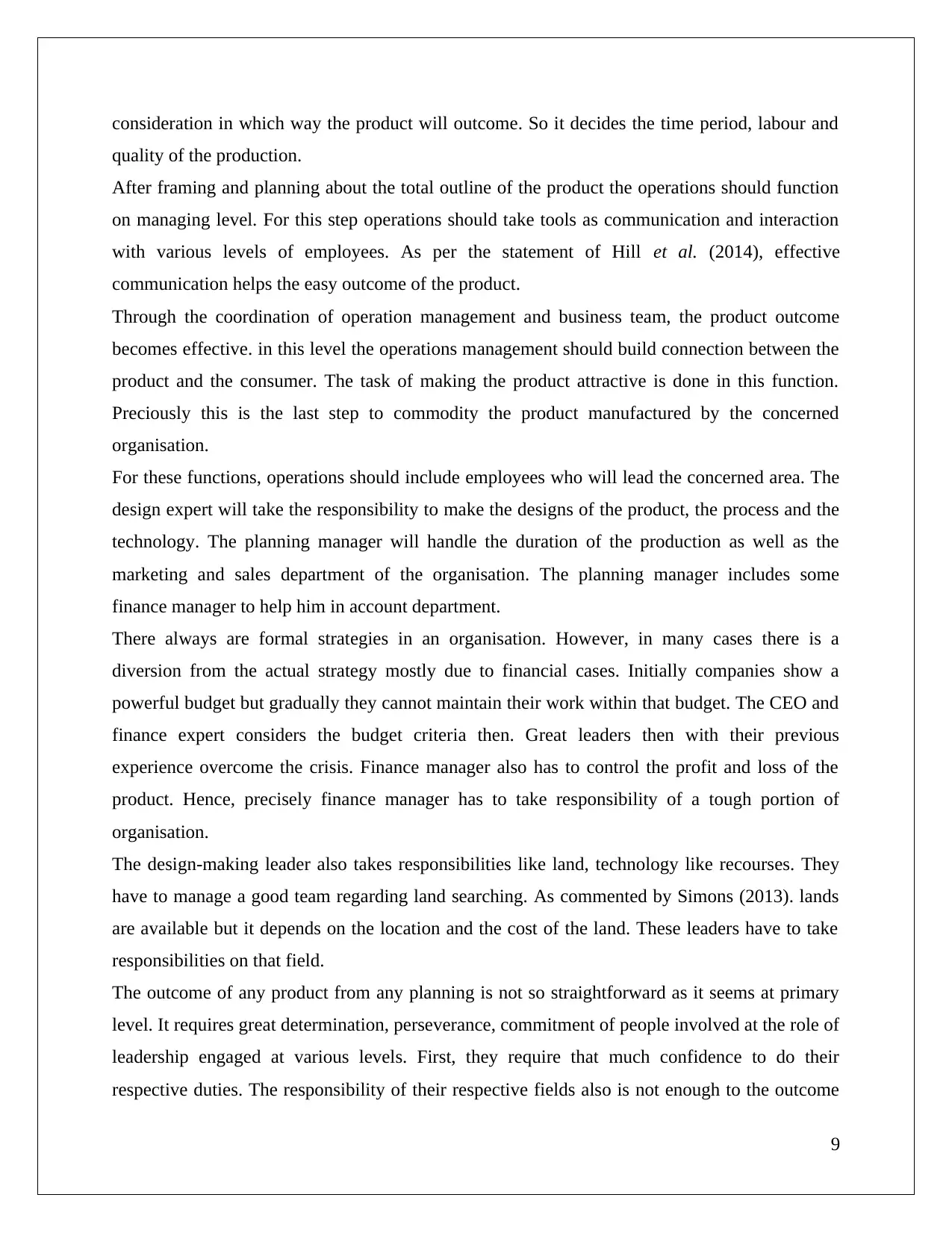
consideration in which way the product will outcome. So it decides the time period, labour and
quality of the production.
After framing and planning about the total outline of the product the operations should function
on managing level. For this step operations should take tools as communication and interaction
with various levels of employees. As per the statement of Hill et al. (2014), effective
communication helps the easy outcome of the product.
Through the coordination of operation management and business team, the product outcome
becomes effective. in this level the operations management should build connection between the
product and the consumer. The task of making the product attractive is done in this function.
Preciously this is the last step to commodity the product manufactured by the concerned
organisation.
For these functions, operations should include employees who will lead the concerned area. The
design expert will take the responsibility to make the designs of the product, the process and the
technology. The planning manager will handle the duration of the production as well as the
marketing and sales department of the organisation. The planning manager includes some
finance manager to help him in account department.
There always are formal strategies in an organisation. However, in many cases there is a
diversion from the actual strategy mostly due to financial cases. Initially companies show a
powerful budget but gradually they cannot maintain their work within that budget. The CEO and
finance expert considers the budget criteria then. Great leaders then with their previous
experience overcome the crisis. Finance manager also has to control the profit and loss of the
product. Hence, precisely finance manager has to take responsibility of a tough portion of
organisation.
The design-making leader also takes responsibilities like land, technology like recourses. They
have to manage a good team regarding land searching. As commented by Simons (2013). lands
are available but it depends on the location and the cost of the land. These leaders have to take
responsibilities on that field.
The outcome of any product from any planning is not so straightforward as it seems at primary
level. It requires great determination, perseverance, commitment of people involved at the role of
leadership engaged at various levels. First, they require that much confidence to do their
respective duties. The responsibility of their respective fields also is not enough to the outcome
9
quality of the production.
After framing and planning about the total outline of the product the operations should function
on managing level. For this step operations should take tools as communication and interaction
with various levels of employees. As per the statement of Hill et al. (2014), effective
communication helps the easy outcome of the product.
Through the coordination of operation management and business team, the product outcome
becomes effective. in this level the operations management should build connection between the
product and the consumer. The task of making the product attractive is done in this function.
Preciously this is the last step to commodity the product manufactured by the concerned
organisation.
For these functions, operations should include employees who will lead the concerned area. The
design expert will take the responsibility to make the designs of the product, the process and the
technology. The planning manager will handle the duration of the production as well as the
marketing and sales department of the organisation. The planning manager includes some
finance manager to help him in account department.
There always are formal strategies in an organisation. However, in many cases there is a
diversion from the actual strategy mostly due to financial cases. Initially companies show a
powerful budget but gradually they cannot maintain their work within that budget. The CEO and
finance expert considers the budget criteria then. Great leaders then with their previous
experience overcome the crisis. Finance manager also has to control the profit and loss of the
product. Hence, precisely finance manager has to take responsibility of a tough portion of
organisation.
The design-making leader also takes responsibilities like land, technology like recourses. They
have to manage a good team regarding land searching. As commented by Simons (2013). lands
are available but it depends on the location and the cost of the land. These leaders have to take
responsibilities on that field.
The outcome of any product from any planning is not so straightforward as it seems at primary
level. It requires great determination, perseverance, commitment of people involved at the role of
leadership engaged at various levels. First, they require that much confidence to do their
respective duties. The responsibility of their respective fields also is not enough to the outcome
9
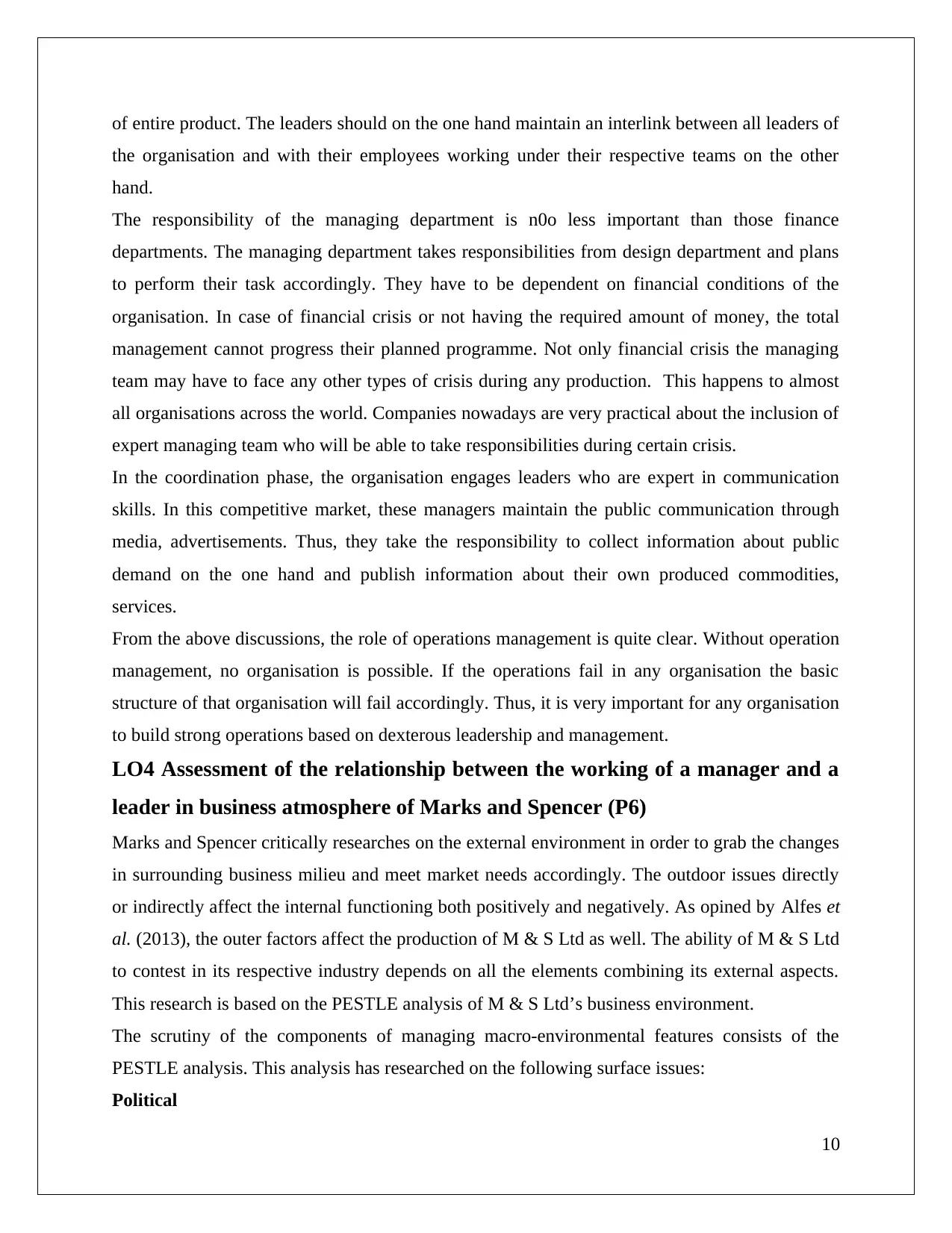
of entire product. The leaders should on the one hand maintain an interlink between all leaders of
the organisation and with their employees working under their respective teams on the other
hand.
The responsibility of the managing department is n0o less important than those finance
departments. The managing department takes responsibilities from design department and plans
to perform their task accordingly. They have to be dependent on financial conditions of the
organisation. In case of financial crisis or not having the required amount of money, the total
management cannot progress their planned programme. Not only financial crisis the managing
team may have to face any other types of crisis during any production. This happens to almost
all organisations across the world. Companies nowadays are very practical about the inclusion of
expert managing team who will be able to take responsibilities during certain crisis.
In the coordination phase, the organisation engages leaders who are expert in communication
skills. In this competitive market, these managers maintain the public communication through
media, advertisements. Thus, they take the responsibility to collect information about public
demand on the one hand and publish information about their own produced commodities,
services.
From the above discussions, the role of operations management is quite clear. Without operation
management, no organisation is possible. If the operations fail in any organisation the basic
structure of that organisation will fail accordingly. Thus, it is very important for any organisation
to build strong operations based on dexterous leadership and management.
LO4 Assessment of the relationship between the working of a manager and a
leader in business atmosphere of Marks and Spencer (P6)
Marks and Spencer critically researches on the external environment in order to grab the changes
in surrounding business milieu and meet market needs accordingly. The outdoor issues directly
or indirectly affect the internal functioning both positively and negatively. As opined by Alfes et
al. (2013), the outer factors affect the production of M & S Ltd as well. The ability of M & S Ltd
to contest in its respective industry depends on all the elements combining its external aspects.
This research is based on the PESTLE analysis of M & S Ltd’s business environment.
The scrutiny of the components of managing macro-environmental features consists of the
PESTLE analysis. This analysis has researched on the following surface issues:
Political
10
the organisation and with their employees working under their respective teams on the other
hand.
The responsibility of the managing department is n0o less important than those finance
departments. The managing department takes responsibilities from design department and plans
to perform their task accordingly. They have to be dependent on financial conditions of the
organisation. In case of financial crisis or not having the required amount of money, the total
management cannot progress their planned programme. Not only financial crisis the managing
team may have to face any other types of crisis during any production. This happens to almost
all organisations across the world. Companies nowadays are very practical about the inclusion of
expert managing team who will be able to take responsibilities during certain crisis.
In the coordination phase, the organisation engages leaders who are expert in communication
skills. In this competitive market, these managers maintain the public communication through
media, advertisements. Thus, they take the responsibility to collect information about public
demand on the one hand and publish information about their own produced commodities,
services.
From the above discussions, the role of operations management is quite clear. Without operation
management, no organisation is possible. If the operations fail in any organisation the basic
structure of that organisation will fail accordingly. Thus, it is very important for any organisation
to build strong operations based on dexterous leadership and management.
LO4 Assessment of the relationship between the working of a manager and a
leader in business atmosphere of Marks and Spencer (P6)
Marks and Spencer critically researches on the external environment in order to grab the changes
in surrounding business milieu and meet market needs accordingly. The outdoor issues directly
or indirectly affect the internal functioning both positively and negatively. As opined by Alfes et
al. (2013), the outer factors affect the production of M & S Ltd as well. The ability of M & S Ltd
to contest in its respective industry depends on all the elements combining its external aspects.
This research is based on the PESTLE analysis of M & S Ltd’s business environment.
The scrutiny of the components of managing macro-environmental features consists of the
PESTLE analysis. This analysis has researched on the following surface issues:
Political
10
Secure Best Marks with AI Grader
Need help grading? Try our AI Grader for instant feedback on your assignments.
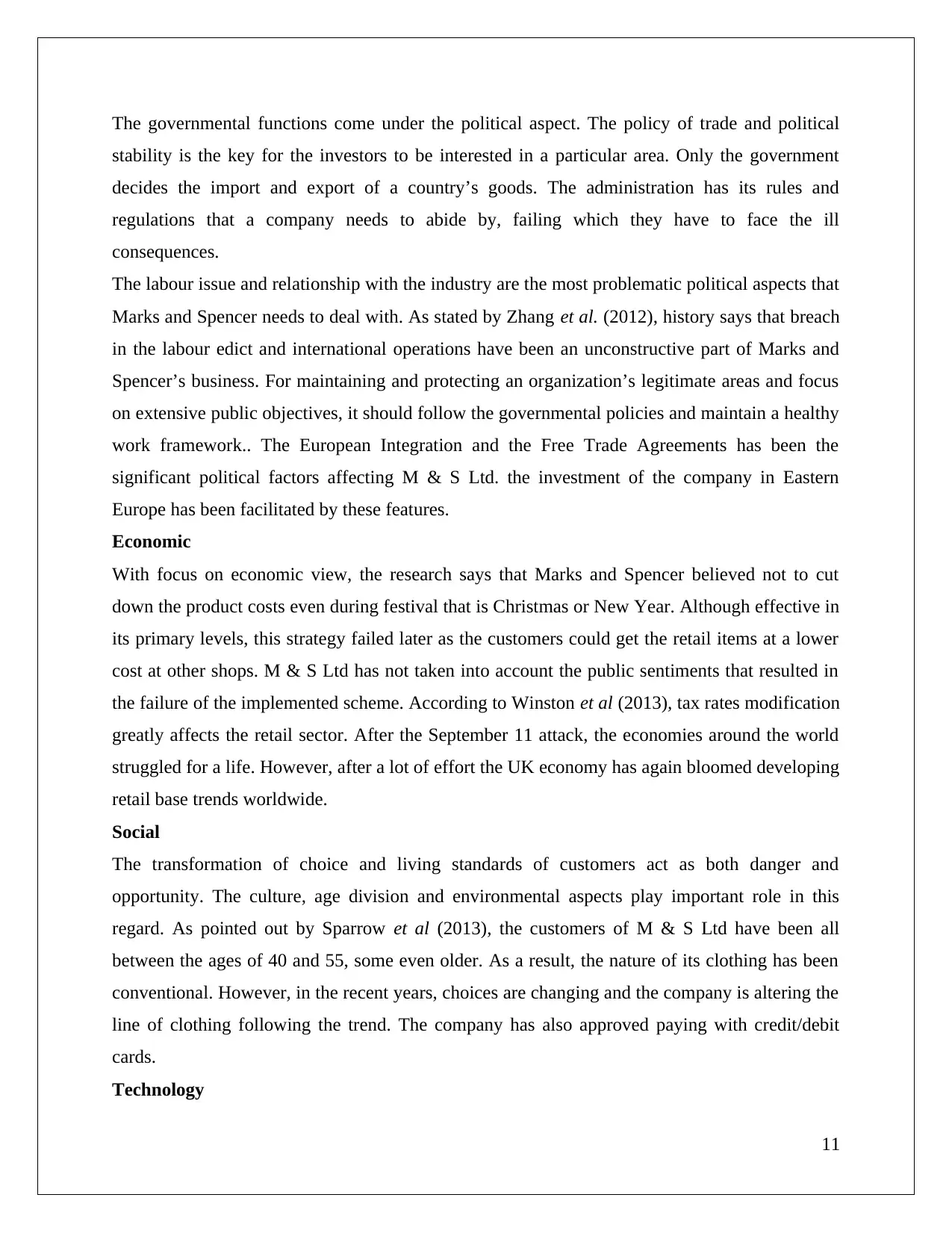
The governmental functions come under the political aspect. The policy of trade and political
stability is the key for the investors to be interested in a particular area. Only the government
decides the import and export of a country’s goods. The administration has its rules and
regulations that a company needs to abide by, failing which they have to face the ill
consequences.
The labour issue and relationship with the industry are the most problematic political aspects that
Marks and Spencer needs to deal with. As stated by Zhang et al. (2012), history says that breach
in the labour edict and international operations have been an unconstructive part of Marks and
Spencer’s business. For maintaining and protecting an organization’s legitimate areas and focus
on extensive public objectives, it should follow the governmental policies and maintain a healthy
work framework.. The European Integration and the Free Trade Agreements has been the
significant political factors affecting M & S Ltd. the investment of the company in Eastern
Europe has been facilitated by these features.
Economic
With focus on economic view, the research says that Marks and Spencer believed not to cut
down the product costs even during festival that is Christmas or New Year. Although effective in
its primary levels, this strategy failed later as the customers could get the retail items at a lower
cost at other shops. M & S Ltd has not taken into account the public sentiments that resulted in
the failure of the implemented scheme. According to Winston et al (2013), tax rates modification
greatly affects the retail sector. After the September 11 attack, the economies around the world
struggled for a life. However, after a lot of effort the UK economy has again bloomed developing
retail base trends worldwide.
Social
The transformation of choice and living standards of customers act as both danger and
opportunity. The culture, age division and environmental aspects play important role in this
regard. As pointed out by Sparrow et al (2013), the customers of M & S Ltd have been all
between the ages of 40 and 55, some even older. As a result, the nature of its clothing has been
conventional. However, in the recent years, choices are changing and the company is altering the
line of clothing following the trend. The company has also approved paying with credit/debit
cards.
Technology
11
stability is the key for the investors to be interested in a particular area. Only the government
decides the import and export of a country’s goods. The administration has its rules and
regulations that a company needs to abide by, failing which they have to face the ill
consequences.
The labour issue and relationship with the industry are the most problematic political aspects that
Marks and Spencer needs to deal with. As stated by Zhang et al. (2012), history says that breach
in the labour edict and international operations have been an unconstructive part of Marks and
Spencer’s business. For maintaining and protecting an organization’s legitimate areas and focus
on extensive public objectives, it should follow the governmental policies and maintain a healthy
work framework.. The European Integration and the Free Trade Agreements has been the
significant political factors affecting M & S Ltd. the investment of the company in Eastern
Europe has been facilitated by these features.
Economic
With focus on economic view, the research says that Marks and Spencer believed not to cut
down the product costs even during festival that is Christmas or New Year. Although effective in
its primary levels, this strategy failed later as the customers could get the retail items at a lower
cost at other shops. M & S Ltd has not taken into account the public sentiments that resulted in
the failure of the implemented scheme. According to Winston et al (2013), tax rates modification
greatly affects the retail sector. After the September 11 attack, the economies around the world
struggled for a life. However, after a lot of effort the UK economy has again bloomed developing
retail base trends worldwide.
Social
The transformation of choice and living standards of customers act as both danger and
opportunity. The culture, age division and environmental aspects play important role in this
regard. As pointed out by Sparrow et al (2013), the customers of M & S Ltd have been all
between the ages of 40 and 55, some even older. As a result, the nature of its clothing has been
conventional. However, in the recent years, choices are changing and the company is altering the
line of clothing following the trend. The company has also approved paying with credit/debit
cards.
Technology
11
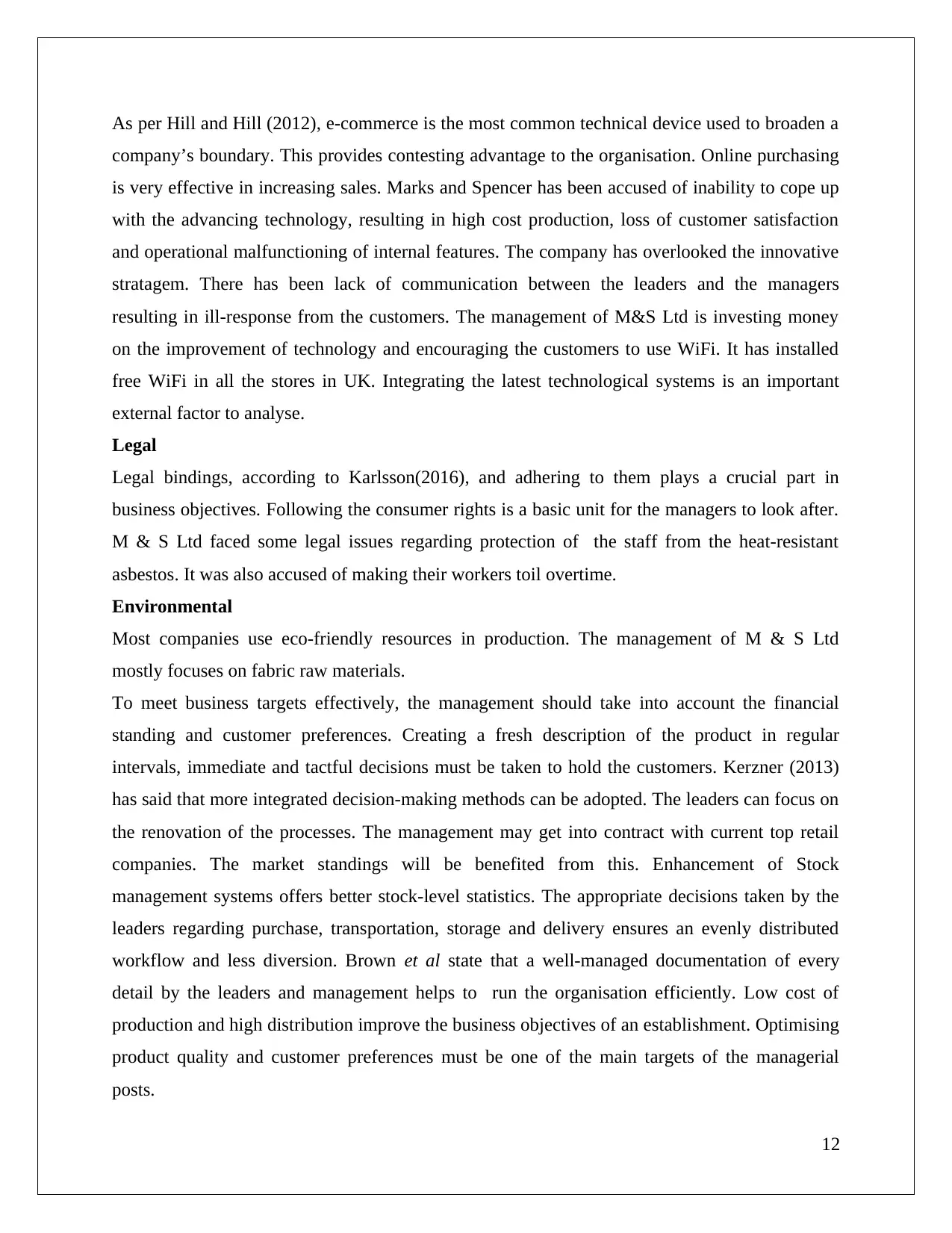
As per Hill and Hill (2012), e-commerce is the most common technical device used to broaden a
company’s boundary. This provides contesting advantage to the organisation. Online purchasing
is very effective in increasing sales. Marks and Spencer has been accused of inability to cope up
with the advancing technology, resulting in high cost production, loss of customer satisfaction
and operational malfunctioning of internal features. The company has overlooked the innovative
stratagem. There has been lack of communication between the leaders and the managers
resulting in ill-response from the customers. The management of M&S Ltd is investing money
on the improvement of technology and encouraging the customers to use WiFi. It has installed
free WiFi in all the stores in UK. Integrating the latest technological systems is an important
external factor to analyse.
Legal
Legal bindings, according to Karlsson(2016), and adhering to them plays a crucial part in
business objectives. Following the consumer rights is a basic unit for the managers to look after.
M & S Ltd faced some legal issues regarding protection of the staff from the heat-resistant
asbestos. It was also accused of making their workers toil overtime.
Environmental
Most companies use eco-friendly resources in production. The management of M & S Ltd
mostly focuses on fabric raw materials.
To meet business targets effectively, the management should take into account the financial
standing and customer preferences. Creating a fresh description of the product in regular
intervals, immediate and tactful decisions must be taken to hold the customers. Kerzner (2013)
has said that more integrated decision-making methods can be adopted. The leaders can focus on
the renovation of the processes. The management may get into contract with current top retail
companies. The market standings will be benefited from this. Enhancement of Stock
management systems offers better stock-level statistics. The appropriate decisions taken by the
leaders regarding purchase, transportation, storage and delivery ensures an evenly distributed
workflow and less diversion. Brown et al state that a well-managed documentation of every
detail by the leaders and management helps to run the organisation efficiently. Low cost of
production and high distribution improve the business objectives of an establishment. Optimising
product quality and customer preferences must be one of the main targets of the managerial
posts.
12
company’s boundary. This provides contesting advantage to the organisation. Online purchasing
is very effective in increasing sales. Marks and Spencer has been accused of inability to cope up
with the advancing technology, resulting in high cost production, loss of customer satisfaction
and operational malfunctioning of internal features. The company has overlooked the innovative
stratagem. There has been lack of communication between the leaders and the managers
resulting in ill-response from the customers. The management of M&S Ltd is investing money
on the improvement of technology and encouraging the customers to use WiFi. It has installed
free WiFi in all the stores in UK. Integrating the latest technological systems is an important
external factor to analyse.
Legal
Legal bindings, according to Karlsson(2016), and adhering to them plays a crucial part in
business objectives. Following the consumer rights is a basic unit for the managers to look after.
M & S Ltd faced some legal issues regarding protection of the staff from the heat-resistant
asbestos. It was also accused of making their workers toil overtime.
Environmental
Most companies use eco-friendly resources in production. The management of M & S Ltd
mostly focuses on fabric raw materials.
To meet business targets effectively, the management should take into account the financial
standing and customer preferences. Creating a fresh description of the product in regular
intervals, immediate and tactful decisions must be taken to hold the customers. Kerzner (2013)
has said that more integrated decision-making methods can be adopted. The leaders can focus on
the renovation of the processes. The management may get into contract with current top retail
companies. The market standings will be benefited from this. Enhancement of Stock
management systems offers better stock-level statistics. The appropriate decisions taken by the
leaders regarding purchase, transportation, storage and delivery ensures an evenly distributed
workflow and less diversion. Brown et al state that a well-managed documentation of every
detail by the leaders and management helps to run the organisation efficiently. Low cost of
production and high distribution improve the business objectives of an establishment. Optimising
product quality and customer preferences must be one of the main targets of the managerial
posts.
12
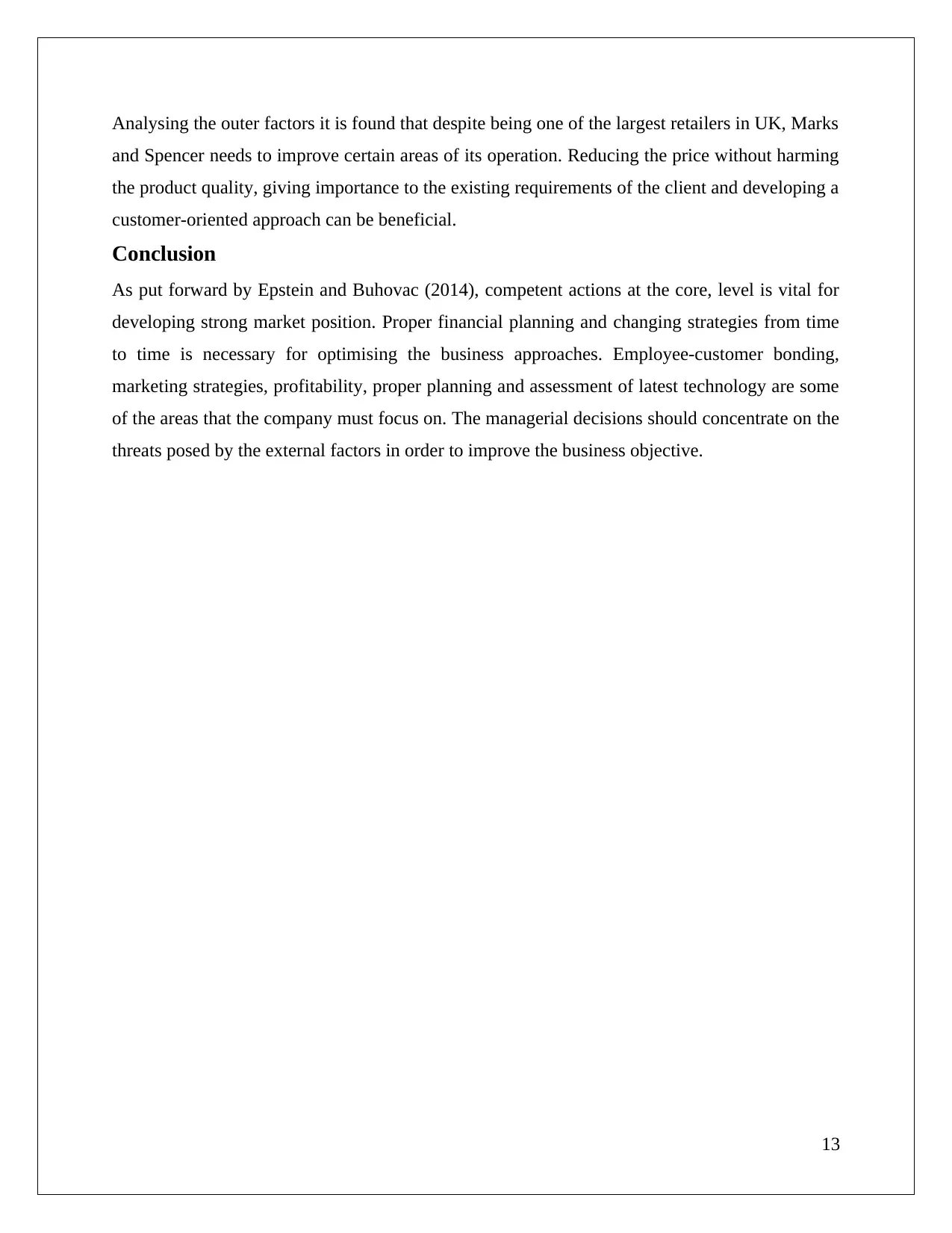
Analysing the outer factors it is found that despite being one of the largest retailers in UK, Marks
and Spencer needs to improve certain areas of its operation. Reducing the price without harming
the product quality, giving importance to the existing requirements of the client and developing a
customer-oriented approach can be beneficial.
Conclusion
As put forward by Epstein and Buhovac (2014), competent actions at the core, level is vital for
developing strong market position. Proper financial planning and changing strategies from time
to time is necessary for optimising the business approaches. Employee-customer bonding,
marketing strategies, profitability, proper planning and assessment of latest technology are some
of the areas that the company must focus on. The managerial decisions should concentrate on the
threats posed by the external factors in order to improve the business objective.
13
and Spencer needs to improve certain areas of its operation. Reducing the price without harming
the product quality, giving importance to the existing requirements of the client and developing a
customer-oriented approach can be beneficial.
Conclusion
As put forward by Epstein and Buhovac (2014), competent actions at the core, level is vital for
developing strong market position. Proper financial planning and changing strategies from time
to time is necessary for optimising the business approaches. Employee-customer bonding,
marketing strategies, profitability, proper planning and assessment of latest technology are some
of the areas that the company must focus on. The managerial decisions should concentrate on the
threats posed by the external factors in order to improve the business objective.
13
Paraphrase This Document
Need a fresh take? Get an instant paraphrase of this document with our AI Paraphraser
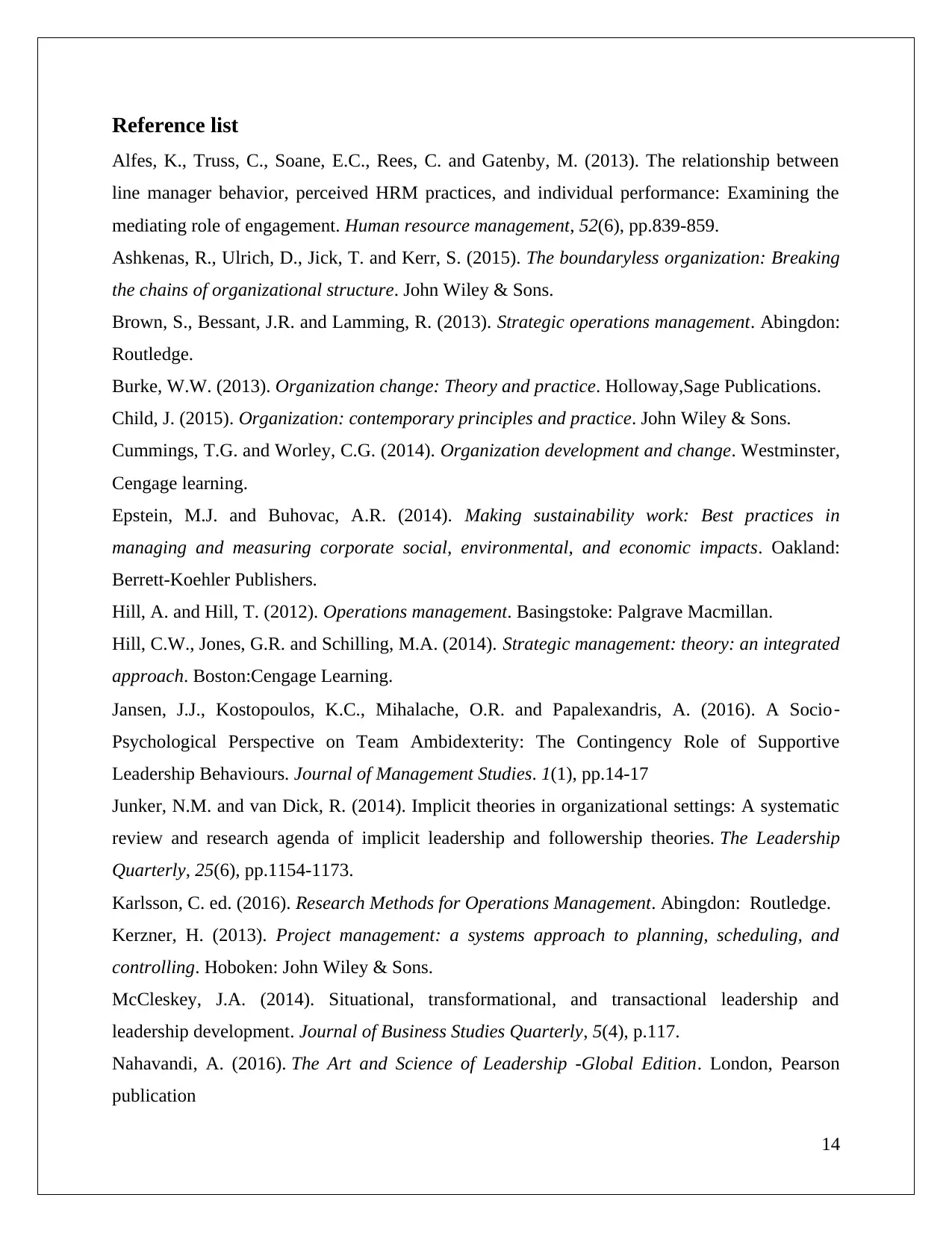
Reference list
Alfes, K., Truss, C., Soane, E.C., Rees, C. and Gatenby, M. (2013). The relationship between
line manager behavior, perceived HRM practices, and individual performance: Examining the
mediating role of engagement. Human resource management, 52(6), pp.839-859.
Ashkenas, R., Ulrich, D., Jick, T. and Kerr, S. (2015). The boundaryless organization: Breaking
the chains of organizational structure. John Wiley & Sons.
Brown, S., Bessant, J.R. and Lamming, R. (2013). Strategic operations management. Abingdon:
Routledge.
Burke, W.W. (2013). Organization change: Theory and practice. Holloway,Sage Publications.
Child, J. (2015). Organization: contemporary principles and practice. John Wiley & Sons.
Cummings, T.G. and Worley, C.G. (2014). Organization development and change. Westminster,
Cengage learning.
Epstein, M.J. and Buhovac, A.R. (2014). Making sustainability work: Best practices in
managing and measuring corporate social, environmental, and economic impacts. Oakland:
Berrett-Koehler Publishers.
Hill, A. and Hill, T. (2012). Operations management. Basingstoke: Palgrave Macmillan.
Hill, C.W., Jones, G.R. and Schilling, M.A. (2014). Strategic management: theory: an integrated
approach. Boston:Cengage Learning.
Jansen, J.J., Kostopoulos, K.C., Mihalache, O.R. and Papalexandris, A. (2016). A Socio‐
Psychological Perspective on Team Ambidexterity: The Contingency Role of Supportive
Leadership Behaviours. Journal of Management Studies. 1(1), pp.14-17
Junker, N.M. and van Dick, R. (2014). Implicit theories in organizational settings: A systematic
review and research agenda of implicit leadership and followership theories. The Leadership
Quarterly, 25(6), pp.1154-1173.
Karlsson, C. ed. (2016). Research Methods for Operations Management. Abingdon: Routledge.
Kerzner, H. (2013). Project management: a systems approach to planning, scheduling, and
controlling. Hoboken: John Wiley & Sons.
McCleskey, J.A. (2014). Situational, transformational, and transactional leadership and
leadership development. Journal of Business Studies Quarterly, 5(4), p.117.
Nahavandi, A. (2016). The Art and Science of Leadership -Global Edition. London, Pearson
publication
14
Alfes, K., Truss, C., Soane, E.C., Rees, C. and Gatenby, M. (2013). The relationship between
line manager behavior, perceived HRM practices, and individual performance: Examining the
mediating role of engagement. Human resource management, 52(6), pp.839-859.
Ashkenas, R., Ulrich, D., Jick, T. and Kerr, S. (2015). The boundaryless organization: Breaking
the chains of organizational structure. John Wiley & Sons.
Brown, S., Bessant, J.R. and Lamming, R. (2013). Strategic operations management. Abingdon:
Routledge.
Burke, W.W. (2013). Organization change: Theory and practice. Holloway,Sage Publications.
Child, J. (2015). Organization: contemporary principles and practice. John Wiley & Sons.
Cummings, T.G. and Worley, C.G. (2014). Organization development and change. Westminster,
Cengage learning.
Epstein, M.J. and Buhovac, A.R. (2014). Making sustainability work: Best practices in
managing and measuring corporate social, environmental, and economic impacts. Oakland:
Berrett-Koehler Publishers.
Hill, A. and Hill, T. (2012). Operations management. Basingstoke: Palgrave Macmillan.
Hill, C.W., Jones, G.R. and Schilling, M.A. (2014). Strategic management: theory: an integrated
approach. Boston:Cengage Learning.
Jansen, J.J., Kostopoulos, K.C., Mihalache, O.R. and Papalexandris, A. (2016). A Socio‐
Psychological Perspective on Team Ambidexterity: The Contingency Role of Supportive
Leadership Behaviours. Journal of Management Studies. 1(1), pp.14-17
Junker, N.M. and van Dick, R. (2014). Implicit theories in organizational settings: A systematic
review and research agenda of implicit leadership and followership theories. The Leadership
Quarterly, 25(6), pp.1154-1173.
Karlsson, C. ed. (2016). Research Methods for Operations Management. Abingdon: Routledge.
Kerzner, H. (2013). Project management: a systems approach to planning, scheduling, and
controlling. Hoboken: John Wiley & Sons.
McCleskey, J.A. (2014). Situational, transformational, and transactional leadership and
leadership development. Journal of Business Studies Quarterly, 5(4), p.117.
Nahavandi, A. (2016). The Art and Science of Leadership -Global Edition. London, Pearson
publication
14
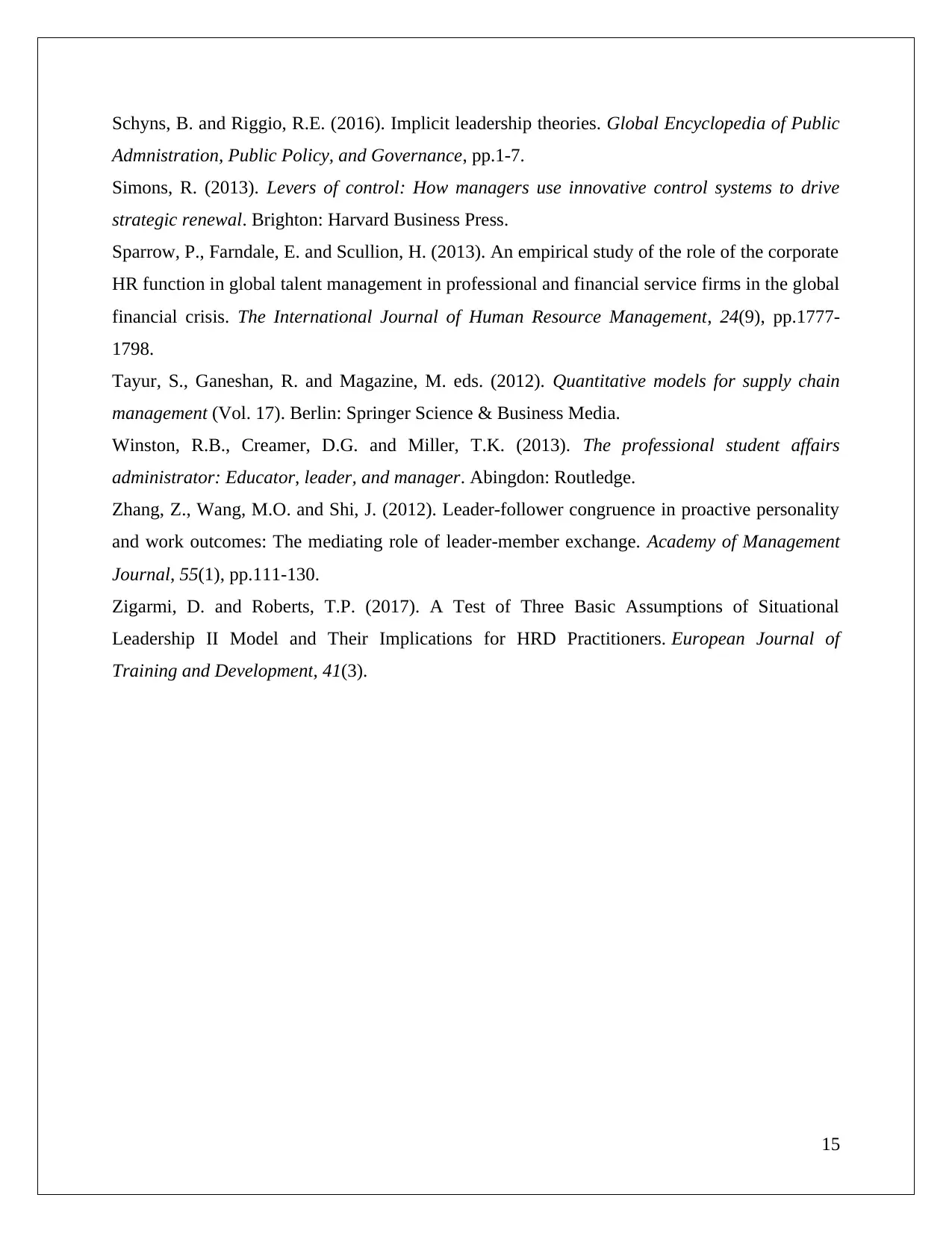
Schyns, B. and Riggio, R.E. (2016). Implicit leadership theories. Global Encyclopedia of Public
Admnistration, Public Policy, and Governance, pp.1-7.
Simons, R. (2013). Levers of control: How managers use innovative control systems to drive
strategic renewal. Brighton: Harvard Business Press.
Sparrow, P., Farndale, E. and Scullion, H. (2013). An empirical study of the role of the corporate
HR function in global talent management in professional and financial service firms in the global
financial crisis. The International Journal of Human Resource Management, 24(9), pp.1777-
1798.
Tayur, S., Ganeshan, R. and Magazine, M. eds. (2012). Quantitative models for supply chain
management (Vol. 17). Berlin: Springer Science & Business Media.
Winston, R.B., Creamer, D.G. and Miller, T.K. (2013). The professional student affairs
administrator: Educator, leader, and manager. Abingdon: Routledge.
Zhang, Z., Wang, M.O. and Shi, J. (2012). Leader-follower congruence in proactive personality
and work outcomes: The mediating role of leader-member exchange. Academy of Management
Journal, 55(1), pp.111-130.
Zigarmi, D. and Roberts, T.P. (2017). A Test of Three Basic Assumptions of Situational
Leadership II Model and Their Implications for HRD Practitioners. European Journal of
Training and Development, 41(3).
15
Admnistration, Public Policy, and Governance, pp.1-7.
Simons, R. (2013). Levers of control: How managers use innovative control systems to drive
strategic renewal. Brighton: Harvard Business Press.
Sparrow, P., Farndale, E. and Scullion, H. (2013). An empirical study of the role of the corporate
HR function in global talent management in professional and financial service firms in the global
financial crisis. The International Journal of Human Resource Management, 24(9), pp.1777-
1798.
Tayur, S., Ganeshan, R. and Magazine, M. eds. (2012). Quantitative models for supply chain
management (Vol. 17). Berlin: Springer Science & Business Media.
Winston, R.B., Creamer, D.G. and Miller, T.K. (2013). The professional student affairs
administrator: Educator, leader, and manager. Abingdon: Routledge.
Zhang, Z., Wang, M.O. and Shi, J. (2012). Leader-follower congruence in proactive personality
and work outcomes: The mediating role of leader-member exchange. Academy of Management
Journal, 55(1), pp.111-130.
Zigarmi, D. and Roberts, T.P. (2017). A Test of Three Basic Assumptions of Situational
Leadership II Model and Their Implications for HRD Practitioners. European Journal of
Training and Development, 41(3).
15
1 out of 15
Your All-in-One AI-Powered Toolkit for Academic Success.
+13062052269
info@desklib.com
Available 24*7 on WhatsApp / Email
![[object Object]](/_next/static/media/star-bottom.7253800d.svg)
Unlock your academic potential
© 2024 | Zucol Services PVT LTD | All rights reserved.





